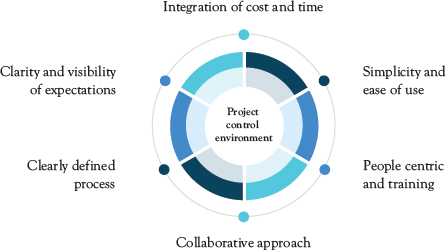The Ingredients of an Effective Project Control Environment
Introduction
The final chapter of this book is devoted to the embedding and promotion of an enabling environment for effective project control. As evident from previous chapters, one of the underlying principles of the PCIM project control methodology is that project control does not operate in a vacuum as it is affected by many factors in the organizational environment (see Chapters 4 and 5 for a detailed discussion on this). In essence, it is not enough for an organization to just have the right processes and tools for project controls; an organization also requires an environment that enables them. This means putting in place the ingredients that support effective project controls dedicatedly. Organizations need to develop deliberately well-designed and intelligent project controls. Figure 12.1 depicts the ingredients that are essential components of such a well-designed and intelligent project control process.
These ingredients are discussed in the sections to follow.
Simplicity and Ease of Use (Simplify Project Controls)
Project control processes, procedures, and systems should be simple, clear, and easy to implement. Poorly designed controls can be overly time consuming and demanding of data, leading to a perception of it outweighing any benefit. Although implementation of project control is a relatively straightforward process, poorly designed project controls can become too complicated for its users. Design of controls needs to be done intelligently and proportionately, ensuring that there is a balance between the time spent operating the control and the added value. Effective project control processes get this balance right so that project staff will be willing to adopt, without perceiving it as extra work but instead seen as part of their project management duties.
Figure 12.1 Key ingredients of an effective project control environment
People-Centric and Training
A project control regime that aspires to be effective should be designed considering the requirements and needs of the people who will be implementing it, especially project delivery and operational staff. Project controls should be aligned to strategic objectives and be designed considering the requirements and needs of the people who will implement them. People are crucial for the smooth operation of any project control process, since any level of analysis and subsequent control will be provided by them. Therefore, project controls would be more effective if project delivery and project management staff understood the science of project control better. However, according to a survey by the PMI (2018), only 45 percent of organizations have a formal process for developing project management competency. An organization that is serious about delivering projects effectively should not only put in place the necessary project control systems and processes but also needs to provide the necessary training needed to implement them correctly.
There is a general tendency to make project control the sole responsibility of a function within an organization such as the project management office, project controls, cost management quantity surveying, commercial, or even finance. For a project control system to be effective, it is important to develop a culture that makes the governance and adherence to project controls not just a matter for a single function but for all areas of an organization. The implementation of effective project controls requires the cooperation of different project stakeholders and coordination among the different departments within an organization, built on a clear understanding of why it is important.
Clearly Defined Processes
Quite often, project controls are too focused on highly configured, complex IT systems, and not focused enough on core processes and practices. Systemization of project control processes is still extremely important; in fact, it is recommended as a key enabler of good project management. However, organizations should not disregard the importance of the processes and practices that will generate the information and data needed to implement the systems. Effective project controls can and should be IT-enabled, but always based on clearly defined core processes.
Clarity and Visibility of Expectations
Have you ever joined an organization and found a process or system difficult to follow? A project control process that will be effective should show adequately what is expected during the various steps of the process. One of the key challenges to effective control of many types of projects is the complexity resulting from the interface, phases, and stages of projects. Project control is also a cycle involving planning, monitoring, reporting, analyzing, and action uitilizing many technical and management processes. Many project controls in practice do not highlight adequately what is expected during the various areas and steps of the control process. For effective project control to be achieved in practice, it is important that lines of communication are clear, and the most up-to-date information is communicated on time and to the relevant persons during the project control process.
An overly prescriptive project control process is not the solution and is not what is being recommended here since projects differ in characteristics. However, project delivery staff on-site, project management leadership, and office-based project staff would find it helpful if project control processes and systems can be easily followed through visibly knowing what is expected, and if possible, the reasons for this during all aspects of the project control process. The project control approach to be adopted on a project needs to be planned at the outset of a project so that the project management team is aligned. Due to the varied level of experience of the project team members, alignment on project control approach is only achievable with the setting up of an organizationwide project controls guidelines and procedures to be utilized for projects in the organization.
Integration of Cost and Time
The interrelationship existing between cost and time during project controls cannot be overstated. For example, as has been discussed previously in this book, the research that informed the PCIM project control methodology revealed that the leading factors inhibiting effective cost control and time control of capital projects are similar (see Chapter 5). But despite this, organizations often don’t integrate cost and time controls in practice as revealed by the PCIM project control research (see Chapter 3). For project control to be effective, organizations must integrate cost and time from the start including at the core of the design of their project control process.
Conclusion
To conclude, this book has argued that project controls tools and techniques do not in themselves make up the project control process because project control is so much more than them. For example, project controls consist of practices that are deployed during the implementation of the project control process. Nondeployment of good practices for the various aspects of the project control process will be detrimental to the project control effort. These practices represent the “how” of project control and differentiate the effectiveness of the project control effort from one project to another or from one organization to another. In addition to practices, it has been shown that the maturity of the project control environment of an organization is also key to the effectiveness of project controls. This book has identified three key categories of “environmental” issues that affect the effectiveness of project controls. Two of these categories (challenges of project controls in practice—see Chapter 3 and project control inhibitors—see Chapter 5) are negative issues in the project control environment that need to be understood, prevented, and mitigated, while the third category of issues as discussed in this chapter are a collection of positive factors (ingredients of an enabling project control environment). In essence, this book and the PCIM project control methodology have shown that the organizational climate in which projects are undertaken has a relationship with project outcomes. Organization’s cultural attributes such as transparency and openness will enable project issues to be raised more freely so they can be dealt with before becoming even bigger problems. Additionally, organizations that have continuous improvement, coaching, mentorship, and role modeling as part of its culture will develop competent project control professionals consistently. Positive outcomes from cultural factors like these underscores the importance of creating an enabling environment for project controls, which will lead to more successful delivery of projects by organizations.

